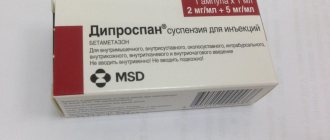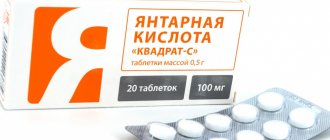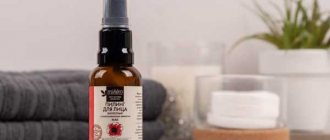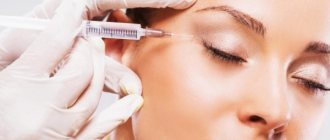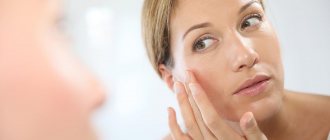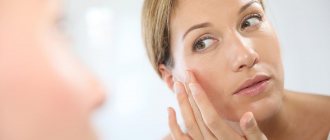Milk peeling is a popular type of superficial chemical peeling that cleanses the skin and gently exfoliates the stratum corneum of the epidermis. Lactic acid is used as the active ingredient. The high effectiveness of this type of peeling is observed at a young age (up to 30-35 years), with sensitive and dehydrated skin.
What are the indications for this procedure?
Lactic acid is produced by Lactobacillus bacteria during the breakdown of glucose.
Thus, being formed from glucose, a natural substance for the body, in most cases, milk peeling does not cause rejection or allergic reactions. Depending on the concentration, lactic acid can act as a superficial (which is more common), superficial-medium and medium peeling. Indications for superficial and medium peels are somewhat different. The most gentle is superficial, indicated for:
- hypersecretion of sebum;
- superficial non-inflammatory comedones and acne;
- hyperkeratosis;
- skin dehydration;
- initial signs of photo- and chronoaging.
Medium peeling works in the deep layers of the epidermis and is relevant for more pronounced changes in photoaging, scarring and post-acne.
What are the contraindications?
Milk peeling is contraindicated in the presence of a number of local changes:
- inflammatory reactions;
- open wounds;
- increased skin sensitivity and thinning.
General contraindications include:
- any disease in the acute stage;
- rosacea;
- oncological processes;
- pregnancy;
- severe hypertension.
You should also remember about the existence of skin phototypes. Different peelings correspond to different skin phototypes. Thus, incorrectly selected peeling for dark skin can lead to a complication - post-peeling hyperpigmentation. For dark skin with Fitzpatrick phototype IV-V, deep peels are contraindicated.
How does acid affect the skin?
In order to understand the reasons for the rejuvenating effect of milk peeling, it is necessary to clarify some aspects of the physiology and anatomy of the skin. The structure of the skin is divided into 3 sections:
- epidermis (topmost layer);
- dermis (actual skin);
- hypodermis (subcutaneous fat tissue).
In this case, the epidermis consists of 5 layers of cells: basal, spinous, granular, shiny, horny.
Aging skin undergoes a number of changes that occur primarily in the dermis and epidermis. Over time, the layers of the skin become thinner and droop, and in addition, solar radiation has a strong negative effect on aging skin. This damage leads to various problems:
- thickening of deformed skin folds;
- solar elastosis;
- uneven pigmentation.
Carcinogenic effects lead to actinic keratoses, basal and squamous cell carcinomas and, to a lesser extent, melanomas.
Scars accumulated over a lifetime from injuries or acne lead to additional changes in skin texture. True age-related skin laxity in the form of drooping eyebrows, bags on the eyelids, jowls and loss of cleavage, lengthening of the earlobe, drooping of the tip of the nose, thinning of the upper lip and other manifestations are now treated surgically through facial rejuvenation procedures (eg, facelift, facelift eyebrows, rhinoplasty, lip augmentation). Conversely, these treatments do not help with textural damage to the skin. Fine wrinkles, large pigmentation irregularities and aging skin are treated with peeling using chemical or mechanical means.
Release form and storage rules
It is important to take into account the percentage of acid in the solution in order to comply with the established dosages. The drug is supplied primarily in the form of a 40% aqueous solution
For sale, it is distributed in containers of 0.1 and 0.5 liters. Some pharmacies and veterinary stores sometimes sell 80% solutions. This is important to consider, since exceeding the established dosages can negatively affect the health of animals
The drug is supplied primarily in the form of a 40% aqueous solution. For sale, it is distributed in containers of 0.1 and 0.5 liters. Some pharmacies and veterinary stores sometimes sell 80% solutions
This is important to consider, since exceeding the established dosages can negatively affect the health of animals
Proper use of acid does not in any way affect the quality of products obtained from animals.
It should be stored in a dark room with a temperature range from - 30˚С to + 45˚С. If the established rules are followed, the substance can be suitable for use for 10 years.
Advantages of this procedure
Peeling in cosmetology involves influencing the skin using chemical reagents that create controlled damage to individual layers of the skin. As a result of specific damage and subsequent regeneration, a number of positive changes occur in tissues:
- improving the appearance of the skin;
- increasing elasticity and tone;
- elimination of fine wrinkles, acne scars and ingrown hairs.
The overall result expected from a chemical peel is soft, supple skin that appears more youthful, with fewer wrinkles and age spots. The most common classification of chemical peels is by depth. On this basis they are divided into:
- superficial (exfoliation – the beginning of the stratum corneum; superficial – the entire stratum corneum);
- middle (light-medium - up to the basal layer; deep-medium - basal layer);
- deep (dermis - performed in a hospital).
Lactic peeling refers to chemical peels that rejuvenate the skin by activating the regeneration of the skin due to the action of lactic acid in different concentrations at different depths of the epidermis and dermis. Lactic acid has a number of positive effects:
- exfoliating;
- moisturizing;
- regenerating;
- whitening;
- anti-inflammatory;
- antibacterial.
Under physiological conditions, it is part of the skin's natural moisturizing factor (NMF).
Superficial peeling affects the entire stratum corneum of the skin, which contains a natural moisturizing factor, the reduction of which causes a feeling of dryness and a flabby appearance. Under the influence of lactic acid, the level of the epidermis decreases and the thickness of the dermis increases, which makes the stratum corneum more elastic and elastic. Strengthening the dermis in this case leads to a lifting effect, improves the protective properties of the skin, and due to the exfoliating effect, refreshes the complexion and reduces hyperpigmentation.
Pharmacological properties
Due to increased functionality of a number of sections of the gastrointestinal tract, more active formation of chewing gum occurs. As a result, an irritating effect is exerted on the mucous membranes. Thus, metabolic processes are accelerated.
But when lactate is applied externally, it turns out:
- keratolytic (10% solution);
- antiseptic (10-30% solution);
- cauterizing effect (10-50% solution).
The choice of concentration will depend on the specific diagnosis and recommendations of the veterinarian. If the undiluted composition gets on the mucous membranes, they must be quickly washed with clean water (warm).
In case of contact with skin, wash with water and soapy water.
Disadvantages of this procedure
Superficial milk peeling is a painless procedure, however, it is worth noting that after it, slight redness may normally appear at the application site and last from several hours to 3 days.
Superficial-medium and median peels can cause itching or burning, erythema after them lasts longer (from 2 to 14 days), temporary whitening of individual areas of the skin may appear - frost, which indicates a deep interaction with skin cells. Such deep peeling is not recommended to be carried out frequently; the frequency is determined by the condition of the skin and is carried out once or in courses once every six months.
Application and dosage
One use is as a dietary supplement by mixing with water.
There are quite a few options for using acid:
- as a dietary supplement (with food and drink);
- for processing household equipment, cauterizing wounds and growths;
- preventive spraying of rabbitry.
Internal use
If rabbits consume the substance orally, then it is necessary to make a 2% (4 - 7.5 ml per individual) or 3% (dosage 3-5 ml) solution. Internal reception is usually prescribed with the presence of:
- enteritis;
- gastritis;
- trichomoniasis;
- bloating of the intestines or stomach;
- flatulence.
You can give acid to baby rabbits to prevent all these conditions 45 days after birth (when they are already separated from their mother). For this purpose, it is enough to dilute a couple of tablespoons of the substance in 10 liters of water and pour this solution into drinking bowls.
If the flatulence is too strong, you need to make a 5% solution and give it to the animal 4 ml at a time. Acid, among other things, helps relax the gastric and intestinal sphincters, reduces the volume and rate of formation of breakdown products.
Spraying
When spraying food, you will need half a milliliter of solution per kilogram of food. Its concentration can be 1 – 4% at your choice. A similar drug is allowed to be used for treating premises.
Spraying the drug is used to disinfect rabbit hutches and prevent diseases.
External use
The following properties of the substance are useful for external use:
- cauterizing (20-40% solution);
- disinfectants (15-30%);
- keratolytic (10%).
All this is necessary to get rid of peptic ulcers and keratinized formations.
How is this peeling done?
To achieve maximum effect, the milk peeling procedure is carried out according to the following scheme:
- The first step is cleansing the skin, but using gel-like textures or neutral soap, since using cosmetic milk reduces the effectiveness of acids.
- After cleansing, the skin is thoroughly dried with a clean paper towel or special swabs.
- Lactic acid is applied quickly and evenly in 1-2 layers using a brush or cotton sponge, avoiding the area around the eyes.
- The exposure time varies depending on the task, but should not exceed 20-25 minutes.
- After washing off the milk peeling, the cosmetologist applies a special neutralizer (alkaline buffer) to the skin. A prerequisite is also to moisturize the skin using a soothing or post-peeling mask.
- The final stage will be photoprotection - the use of creams with spf protection.
The last two rules apply to all types of peelings, regardless of the degree of activity and active substance.
It should be remembered that medium milk peeling, like other medium and deep peels, is not recommended during periods of active sun, as the risk of uneven hyperpigmentation and burns of certain areas of the skin increases due to its increased sensitivity to ultraviolet radiation after the procedure. Superficial milk peeling is less aggressive and has the advantage of having no strict contraindications. It can be performed at any time of the year, as it gently cleanses the skin of dead skin scales and is suitable for sensitive skin.
Links
- Regulation (EU) No 528/2012 of the European Parliament and of the Council of 22 May 2012 concerning the making available on the market and use of biocidal products
- Opinion of the biocidal products committee on the application for approval of the active substance Triclosan in product type 1, ECHA/BPC/066/2015, adopted 17 June 2015
- Opinion of the biocidal products committee on the application for approval of the active substance L(+)-lactic acid in product type 1, ECHA/BPC/084/2015, adopted 10 December 2015
- Regulation (EC) No 1272/2008 on classification, labeling and packaging of substances and mixtures
- SP Denyer, GSAB Stewart, International Biodeterioration & Biodegradation 1998, 41, 261–268
- RE Glover, RR Smith, MV Jones, SK Jackson, CC Rowlands, FEMS Microbiology Letters 1999, 177, 57–62
- JD Van Hamme, A. Singh, OP Ward, Biotechnology Advances 2006, 24, 604–620
- JT Walton, DJ Hill, RG Protheroe, A. Nevill, H. Gibson, Journal of Applied Microbiology 2008, 105, 309–315
This article was originally published in Household and Personal Care Today, January/February 2022, Vol. 12(1), p. 20–21
